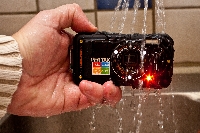Take pictures underwater
By Catalogs Editorial Staff

Take pictures underwater using these useful photography techniques
To take pictures underwater takes a certain amount of confidence and skill. To get the perfect shot will take a true knowledge of both the camera and its capabilities. Below, we’ll take a look at different ways in which you can become a true, top notch, underwater photographer.
Become Comfortable Underwater
Practice in the swimming pool. Here’s why: There are no sharks. Or sting rays. Or jellyfish. The biggest threat you will face may be your kids hitting you on the head with their flotation devices. All kidding aside, the swimming pool can provide a great introductory set of lessons for the novice photographer. Take shots of your kids swimming, and at play, to mimic the speed of which fish and other species will be traveling as you try to take that perfect photo underwater.
As you become more comfortable in the water, practice swimming and floating techniques. There are advantages — according to avid underwater photographer Raul Touzon — with scuba diving as opposed to snorkeling. In scuba diving, one will be closer to the fish and underwater wildlife as they spend more time in deeper water.
Know What You’re Shooting
So you’re shooting a school of fish? You’ve lined up one of the greatest, most beautiful shots this side of the Atlantic, and you’re about to get published. You know it. Except for that large Great White shark coming your way. Whoops. You may not be getting published after all.
It’s simple enough, right? Understand what you’re shooting and the dangers inherent in shooting underwater. There are plenty of spots to shoot and still be safe. Just know the area, the type of animals in the water with you, and things of that nature. What type of animal can you approach? What type is best left undisturbed?
~
Flash or No Flash, That Is the Question?
According to a recent New York Times article, you shouldn’t use a flash underwater because the debris and particles floating nearby will light up like Christmas lights and ruin your shot. The New York Times article also tells you to attach your camera to a float-able wrist strap as well because they have a tendency to sink like stones.
While the New York Times article expresses one current point of view, many experts say use available light. But without said light, the flash becomes even more important. To solve the issues stated above, you can simply lower the strobe power when taking your photo. Always remember, don’t point your camera directly towards the subject of your picture as it will create a backscatter effect that can ruin the shot.
The Right Gear and Settings For You
There are two types of underwater camera systems:
- Point and shoot camera in a waterproof camera case
- A DSLR, or digital single lens reflex
The point and shoot variation has an ease of use that will make it intriguing for new photographers. The cameras work well on the surface of the water but have a tendency not to be able to direct light, which is a major disadvantage for camera owners.
The DSLR is used mostly by professional photographers in the ocean. Control over all facets is absolute, yet it’s sometimes hard to maintain, costly, and hard to maneuver, as well.
For basic settings to know, photographers can learn about:
- White balance: Place it in daylight mode for most shooting circumstances.
- Aperture: For greater depth of field, try shooting between F8 and F16. It’s good to remember that with some of the point and shoot varieties, it may be difficult to operate in a manner quick enough to get the shot you need.
- ISO: Experts will tell you to keep your ISO between 100 and 200. Basically, what ISO means is how sensitive your image sensor is to the amount of light present at your shooting depth. A higher ISO will result in what’s known as digital noise in your shots.
- Speed: To capture motion, use a slower shutter speed. And for images that would like to appear almost as if they are still, go with a higher shutter speed.
Resources:
National Geographic: Underwater
New York Times: How to Take Good Pictures Underwater
Popular Savings Offers
Above photo attributed to Hakan Dahlstrom











